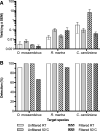Got Glycogen?: Development and Multispecies Validation of the Novel Preserve, Precipitate, Lyse, Precipitate, Purify (PPLPP) Workflow for Environmental DNA Extraction from Longmire's Preserved Water Samples
- PMID: 33100918
- PMCID: PMC7566611
- DOI: 10.7171/jbt.20-3104-003
Got Glycogen?: Development and Multispecies Validation of the Novel Preserve, Precipitate, Lyse, Precipitate, Purify (PPLPP) Workflow for Environmental DNA Extraction from Longmire's Preserved Water Samples
Abstract
Unfiltered and filtered water samples can be used to collect environmental DNA (eDNA). We developed the novel "Preserve, Precipitate, Lyse, Precipitate, Purify" (PPLPP) workflow to efficiently extract eDNA from Longmire's preserved unfiltered and filtered water samples (44-100% recovery). The PPLPP workflow includes initial glycogen-aided isopropanol precipitation, guanidium hypochlorite and Triton X-100-based lysis, terminal glycogen-aided polyethylene glycol precipitation, and inhibitor purification. Three novel eDNA assays that exclusively target species invasive to Australia were also developed: Tilapia_v2_16S concurrently targets Oreochromis mossambicus (Mozambique tilapia) and Tilapia mariae (spotted tilapia) while R.marina_16S and C.caroliniana_matK discretely target Rhinella marina (cane toad) and Cabomba caroliniana (fanwort), respectively. All 3 assays were validated in silico before in vitro and in situ validations using PPLPP workflow extracted samples. PPLPP workflow was concurrently validated in vitro and in situ using all 3 assays. In vitro validations demonstrated that 1) glycogen inclusion increased extracellular DNA recovery by ∼48-fold compared with glycogen exclusion, 2) swinging-bucket centrifugation for 90 min at 3270 g is equivalent to fixed-angle centrifugation for 5-20 min at 6750 g, and 3) Zymo OneStep Inhibitor Removal Kit, Qiagen DNeasy PowerClean Pro Cleanup Kit, and silica-Zymo double purification provide effective inhibitor removal. In situ validation demonstrated 95.8 ± 2.8% (mean ± SEM) detectability across all 3 target species in Longmire's preserved unfiltered and filtered water samples extracted using the PPLPP workflow (without phenol:chloroform:isoamyl alcohol purification) after 39 d of incubation at room temperature and 50°C. PPLPP workflow is recommended for future temperate and tropical eDNA studies that use Longmire's to preserve unfiltered or filtered water samples.
Keywords: eDNA; invasive species; method; tropical.
© Association of Biomolecular Resource Facilities.
Figures





References
-
- Goldberg CS, Turner CR, Deiner K, et al. . Critical considerations for the application of environmental DNA methods to detect aquatic species. Methods Ecol Evol. 2016;7:1299–1307.
-
- Deiner K, Bik HM, Mächler E, et al. . Environmental DNA metabarcoding: transforming how we survey animal and plant communities. Mol Ecol. 2017;26:5872–5895. - PubMed
-
- Tsuji S, Takahara T, Doi H, Shibata N, Yamanaka H. The detection of aquatic macroorganisms using environmental DNA analysis—A review of methods for collection, extraction, and detection. Environmental DNA.2019;1:99–108.
-
- Huerlimann R, Cooper MK, Edmunds RC, et al. . Enhancing tropical conservation and ecology research with aquatic environmental DNA methods: an introduction for non‐environmental DNA specialists [E-pub ahead of print]. Anim Conserv. 2020;.
MeSH terms
Substances
LinkOut - more resources
Full Text Sources
Miscellaneous
